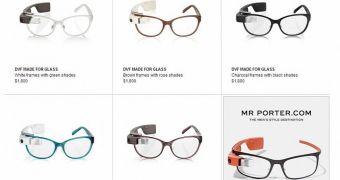Google has just unleashed its Glass device in the United Kingdom, a day ahead of this year’s I/O conference, but it has also made available its high-fashion line of Glass wearables.
The line was created by American Fashion Designer Diane von Furstenberg and it was introduced for the first time earlier this month. The new pieces seek to make the Glass a little bit more fashion-forward as Google tries to attract people who are passionate about the way they look.
The new devices are available for purchase off Google’s own store for Glass, as well as from several online luxury retailers such as Net-A-Porter and Mr. Porter.
While the regular devices cost $1,500 (€ 1,100) for the basic Glass, the designer frames add another $300 (€220) to the price tag. The DVF Made for Glass line comes with five new frames and eight shades options.
Google has certainly captured the attention of the world with this device and now it hopes to lure in even more people as it takes its device across borders and bringing in more and more ideas.
However, the fact that these new frames have been made available and that the beta version of Glass is becoming available in more countries hints to the fact that Google has absolutely no intention to lower the price of Glass when the new version of the device makes its appearance.
There is a chance that the price will drop to some extent when it starts shipping more units, since at this point, Google Glass is somewhat of an exclusive item, but chances are that it won’t reach the $300-$500 (€220 - €367) range that most would be comfortable paying for it.
Until then, however, the company has plenty of troubles to go through because of Glass, including privacy concerns. Unfortunately for Google and the device’s fans, there are quite a few critics slamming left and right.
Businesses have banned the device on their premises, including casinos, restaurants, cafes and movie theaters, while legislators are looking at ways to forbid drivers from wearing Glass while they’re behind the wheel despite the ability to get directions with its help.
Google has been arguing that Glass isn’t as privacy invading as some think since you actually have to make some gestures to take a picture or tell the device to start recording on top of the fact that it makes a beeping noise when it does. It has also been trying to convince authorities that Glass doesn’t intend to make you oblivious of the world around you, but rather to help you see more things, including, in this case, a map and directions to getting from point A to point B.

 14 DAY TRIAL //
14 DAY TRIAL //